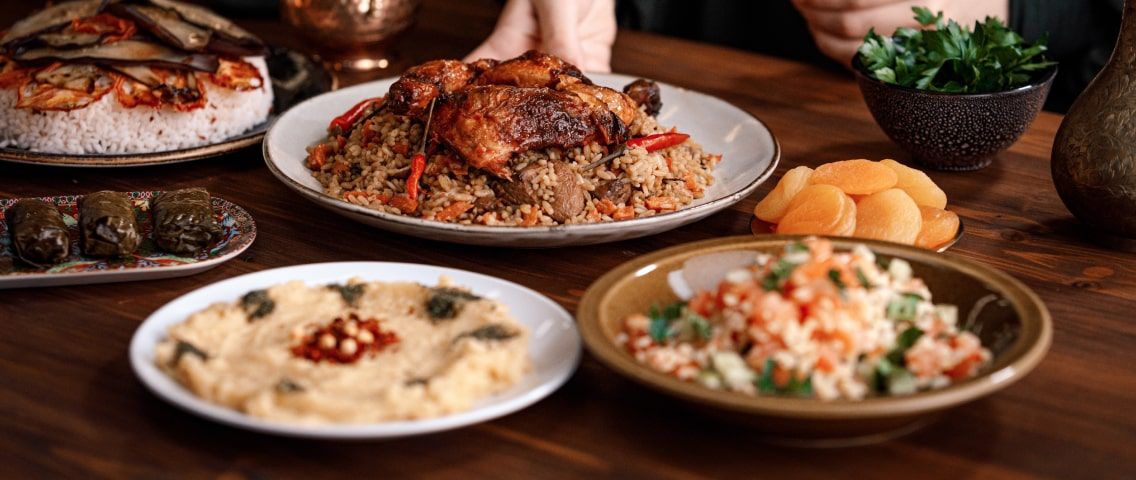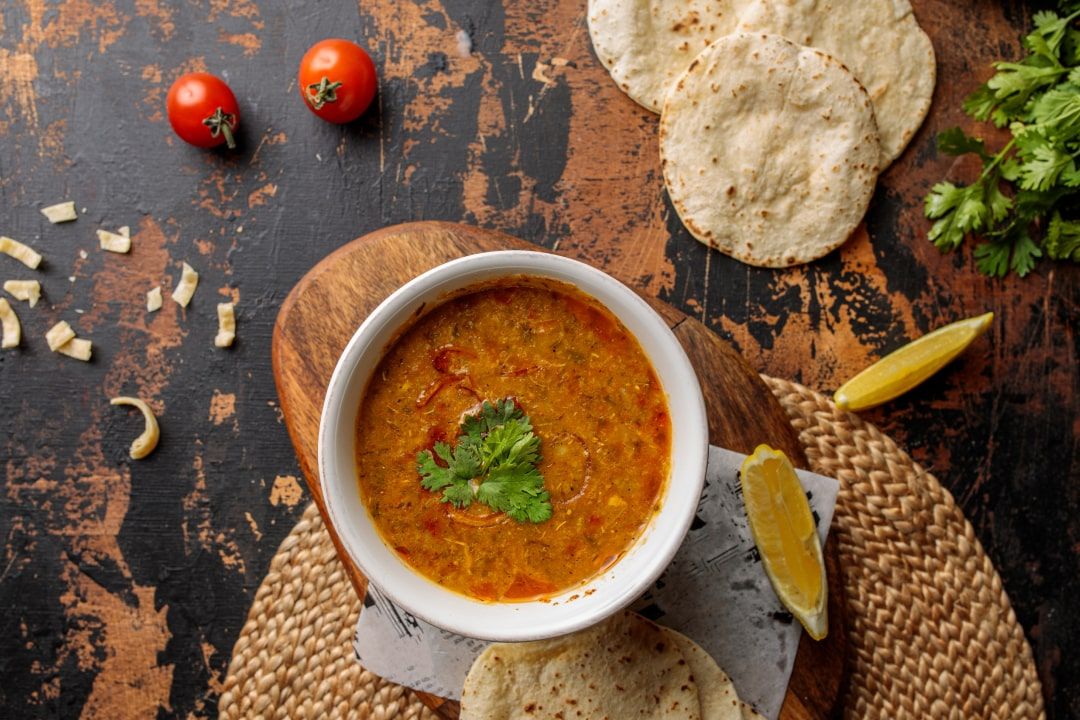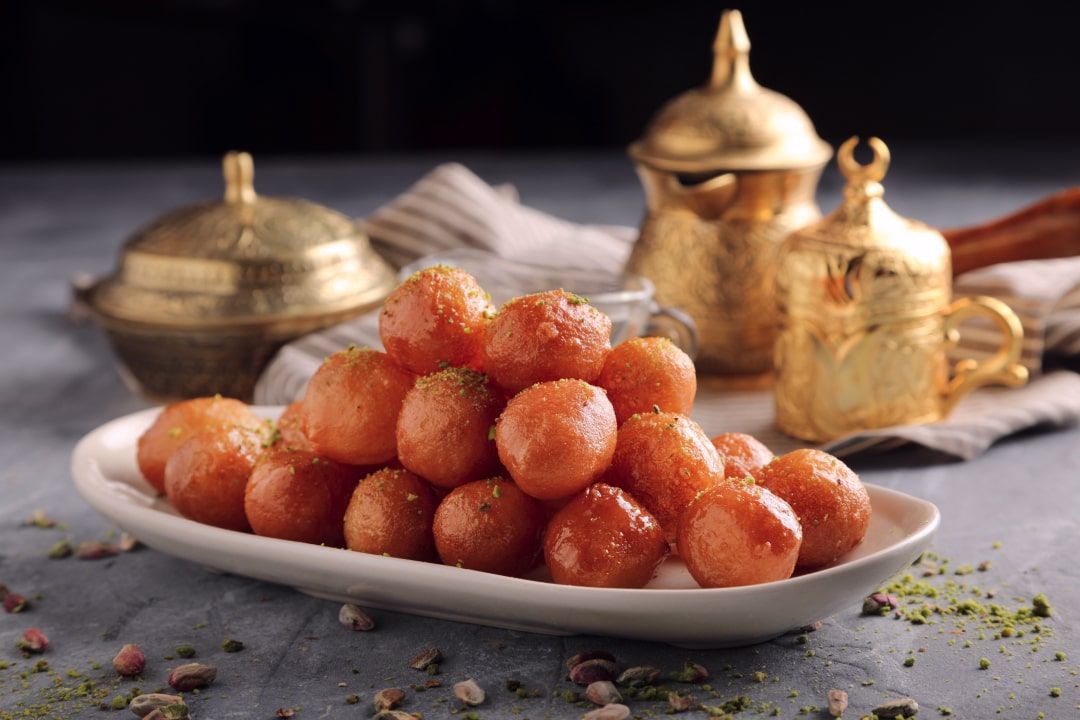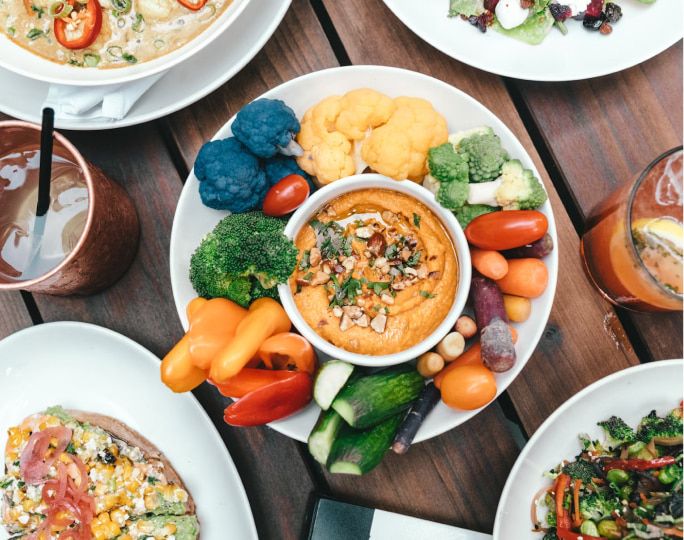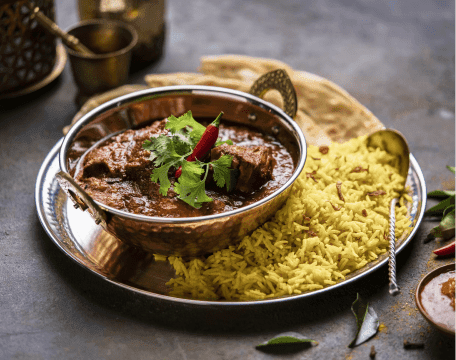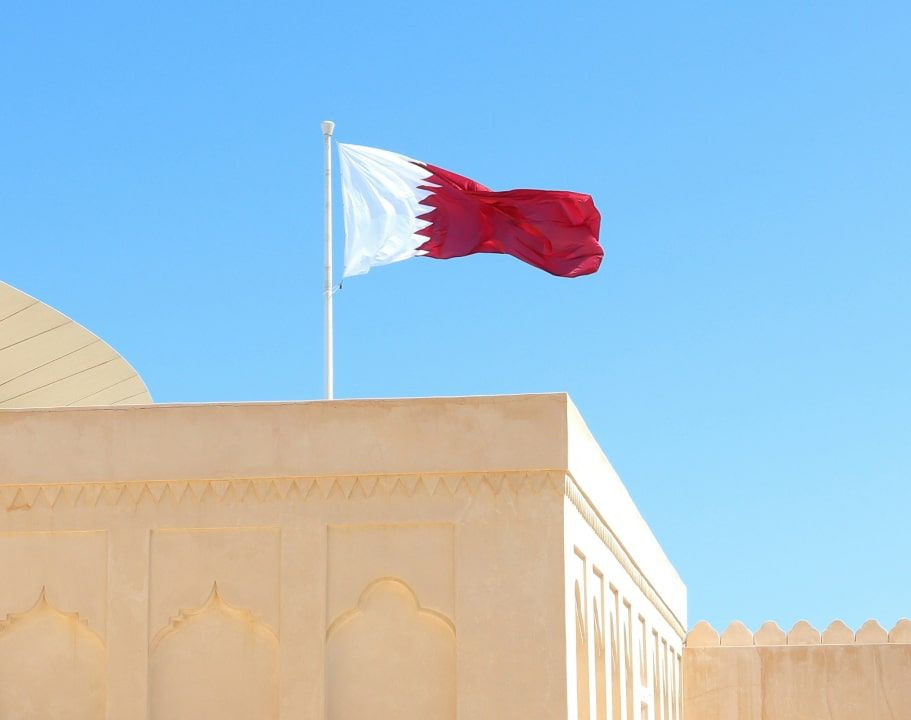Contents
If you’re visiting Qatar, plan for a culinary adventure. Traditional Qatari food is full of flavour, texture, and comfort in every bite. Cardamom, saffron, cinnamon, and turmeric — each one plays its part in this symphony of spices, creating dishes, drinks, and desserts with a signature aroma. Drawing on Persian, Indian, and Bedouin influences, Qatari cuisine is rich in heritage and tastes like edible history.
It’s also about sharing and celebration. Most dishes are made for gatherings, where the best memories are created around the table with something delicious and a side of laughter. From hearty stews like madrouba and harees to sweet treats like luqaimat, Qatar’s food scene caters to all tastes.
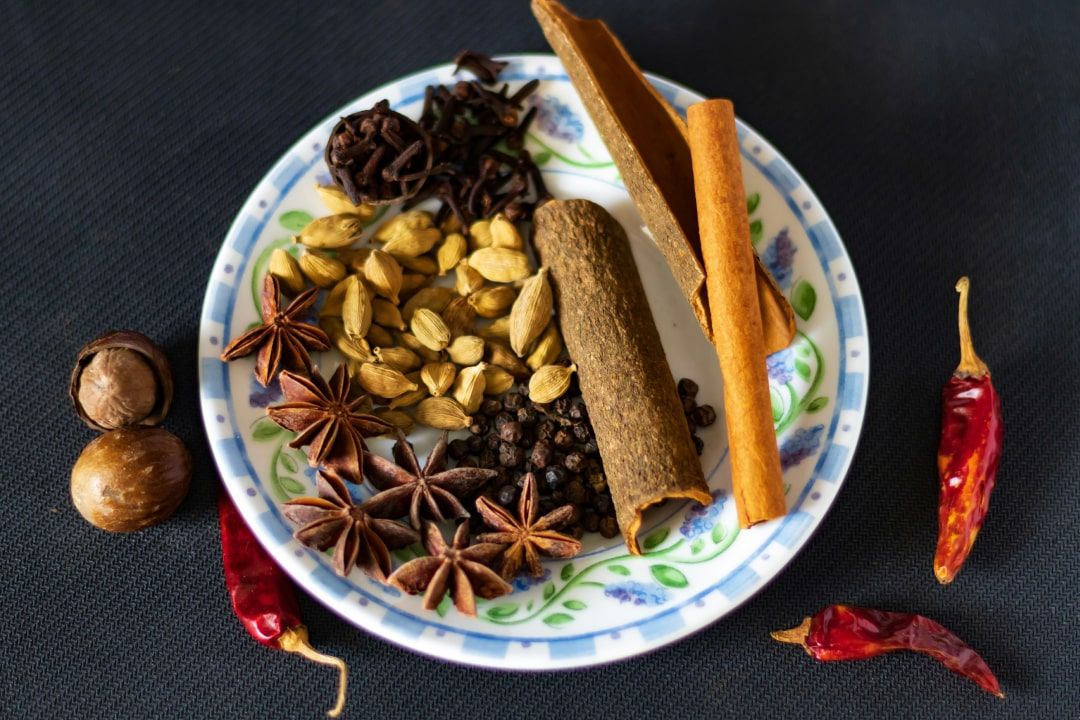
Must-try traditional dishes
Machboos
You can recognize this dish from far away. Once it’s served, the steam fills the room with the fragrant aromas of cardamom, saffron and cinnamon. It’s made with rice and meat — usually lamb or chicken — and rice which gets cooked in the broth to soak up the savory flavors. The meat is made tender to effortlessly mix with the rice and make each bite satisfying. In Qatar, machboos is the most common celebratory dish. It is served for Eid lunches, special celebrations and on Fridays.
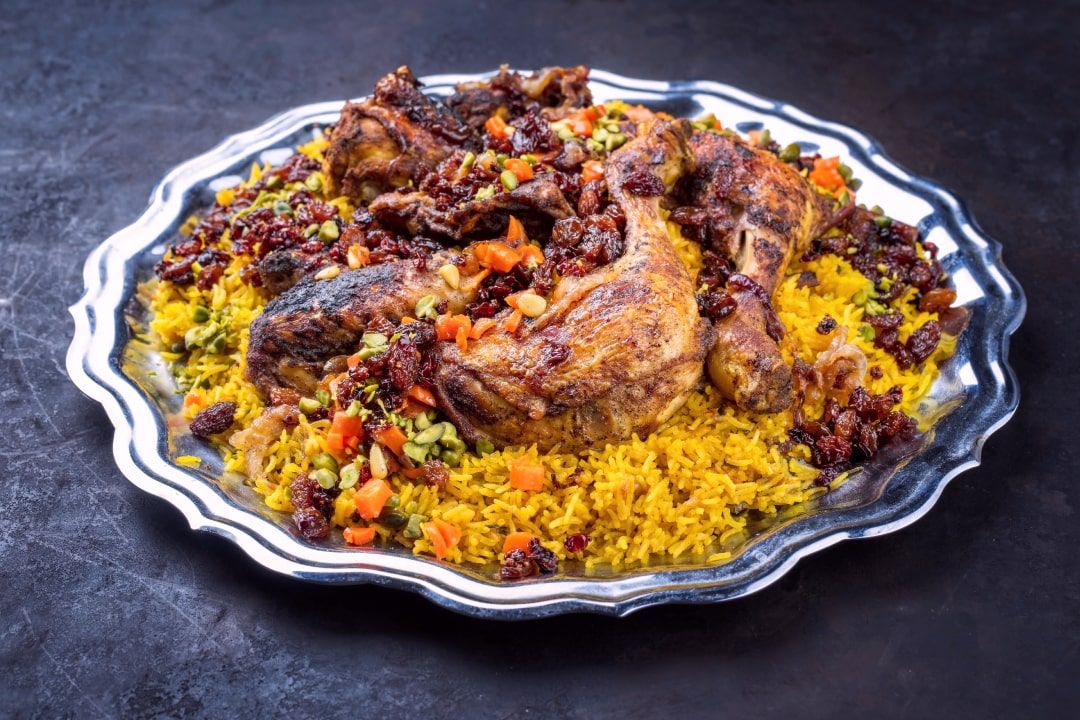
Harees and jareesh
This is porridge taken to a whole new level. Harees is a savory mix of wheat and meat — usually chicken, lamb or camel — that’s been slow-cooked until it practically falls apart. The magic is in the same signature spice mix that offers a blend of earthiness, warmth and sweetness. Some versions toss in a few veggies like onions or tomatoes for a burst of freshness and, you know, vitamins. But the real star is the juicy meat, paired with that silky-smooth wheat. One bite, and you’ll be hooked.
Jareesh is harees’s close cousin. These two dishes have the same ingredients and flavour profile but vary in terms of texture. While harees has a porridge-like consistency, jareesh is made with crushed wheat that gives it a grainy feel.
Madrouba
Madrouba is comfort food taken to the next level. Tender slow-cooked chicken or lamb, mixed with rice that soaks up all the umami goodness until it becomes silky smooth with every bite. Think of it like a close cousin to machboos, but creamier and more comforting. You can sense a theme here. Tender meats and the same traditional seasonings. But what sets madrouba apart is that fresh squeeze of lemon at the end. It cuts through all that richness and gives it just the right amount of zing.
Saloona or thareed
Saloona or thareed are other comforting dishes that hit all the right notes. Tender lamb or fish, simmered with vegetables like carrots, potatoes, and tomatoes to make a harmonious broth. The main difference between the two? In thareed, flatbread — khubz — is torn and soaked in the broth, while saloona is typically served with rice or flatbread on the side.
Margooga
Margooga is another comforting stew that brings braised lamb or chicken, blended with vegetables like carrots, potatoes, and tomatoes and the usual spice mix. This dish stands apart in texture. Margooga is thickened with wheat or flour, making it heartier than saloona and giving it a rich, almost porridge-like consistency. Pair it with khubz, and you’ll be scooping up every last drop of that delicious broth.
Balaleet
Now let’s move from stews and broths to something lighter. Balaleet is breakfast, but not as you know it. It’s made of scrambled eggs, which is standard for any breakfast, but what sets it apart is the base underneath. It’s made of sweet vermicelli noodles spiced with cardamom, cinnamon, and saffron. An unusual mix of sweet and savory that’s worth a try.
Traditional beverages to enjoy
Every great Qatari meal deserves a beverage that matches. Whether you're looking for something to enhance the bold flavors of your dish or need a refreshing pick-me-up afterwards, these drinks will make your dining experience even better.
Karak tea
Karak tea starts with strong black tea, brewed to perfection. Then cardamom is added for an extra kick and balanced out with sweetened condensed milk, making the texture creamy and indulgent. It’s like the tea version of comfort food. Traditionally, karak is served in small cups because — let’s be honest — no one wants to gulp this down too quickly. One sip, and you’ll get why it’s so loved.
Gahwa: Arabic coffee
Gahwa is not your average cup of coffee. It’s a whole ritual. Infused with cardamom and sometimes a little saffron, this brew is light but packed with aromas. You’ll find yourself craving it after a good hearty meal. It’s also served in small cups as it’s meant to be savored slowly and is traditionally paired with dates. Together, they make the perfect pick-me-up combo sweet treat that keeps you going.
Laban: Buttermilk
For something cool and refreshing, laban is your go-to in Qatar. It’s a savory beverage that’s tangy, smooth, light, and a palate’s best friend. After a spicy bite of machboos or saloona, laban steps in to calm your taste buds and settle the spice. It’s like your personal flavor reset button, preparing you for the next round of deliciousness.
Qatari desserts you shouldn’t miss
Got a sweet tooth? You’re in the right place. Let’s dive into the must-try desserts that will leave you craving more. You’ll thank us later.
Luqaimat
Luqaimat are bite-sized golden delights. They’re crispy on the outside, soft and melt-in-your-mouth on the inside. Soaked in date syrup — or honey if you prefer a sweeter kick — and sprinkled with sesame seeds. They hit all the right notes. One bite, and you'll find yourself reaching for another, and another. They’re small but so addictive.
You’ll often find them at street vendors frying fresh in the evening, filling the air with a sweet, irresistible aroma. Whether it’s the start of your day or a quick snack, luqaimat paired with a cup of karak tea or Arabic coffee is the perfect combo.
Aseeda
Next up is aseeda. This creamy dessert made from flour, ghee, and honey is smooth, subtly sweet, and always served warm. Topped with dates or sugar, it’s the kind of treat that’s perfect for Ramadan or Eid but somehow feels right any time of year.
Khabees
Looking for something fragrant and satisfying? Khabees is exactly what you need. Made with flour, sugar, ghee, and a touch of cardamom, it’s a rich, pudding-like treat with a hint of saffron. Its golden color is as inviting as its subtle sweetness, making it the perfect dish for celebrations like Eid or weddings.
Where to eat Qatari food
This isn’t just about eating. It’s about finding that machboos, that balaleet, the one that makes you pause mid-bite and go — “oh, this is it.”
Budget-friendly but full of soul
Harees Al Walda
This spot is your all-in-one Qatari kitchen. Madrouba, thareed, they got it all. And they got it all right. The upstairs seating is cozy, and the prices keep you full without guilt.
Shay Al Shamoos
If Qatar had a breakfast hall of fame, this would be it. The Shay Al Shamoos’ balaleet hits that sweet-salty balance perfectly. The aseeda is warm and gooey like someone’s grandmother made it.
Bandar Aden
Technically Yemeni, but beloved by locals for Qatari favorites too. The thareed here arrives in giant bowls, bread perfectly soaked, and the meat fall-apart soft. Service is quick, even when it’s packed.
Poori & Karak
It’s more of a pit stop than a sit-down, but the balaleet is spot on and served with chapati and a side of karak. Perfect to ease those sugar cravings.
Luqaimaty
Follow your nose and you’ll find these luqaimat stands. They are open in multiple locations around Qatar. No need to overthink it. Grab a box and a napkin.
Mid-range gems
Saasna
Modern Qatari restaurant in a stylish space. Try the thareed with tender lamb and khubz soaked just right. The portions are satisfying, the setting is photogenic, and the prices are fair.
SMAT
A menu that’s rooted in tradition but never boring. SMAT’s balaleet is playful, their aseeda velvety, and they serve classic drinks in designer cups. It’s Qatari food with a side of cool.
Nassayem Qatar
Elegant but approachable. Their khabees is the real star — warm, fragrant, and topped with just the right amount of ghee. The ambiance is classy but not stiff, and the service is quick.
Fine dining
Desert Rose Café
Desert Rose’s madrouba is plated like art. The aseeda arrives as perfect little swirls, and the khabees smells like your favorite spice shop. The dishes are classic but the presentation is very creative. You pay for the food and the atmosphere that makes the experience even special.
Bayt Sharq
Located in a restored villa with garden vibes, Bayt Sharq’s setting feels like a Gulf royal’s backyard brunch. Their saloona is decadent and balanced.
Yasmine Palace
The sea breeze here makes everything taste even better. A good option if you need a good view and a hearty Qatari meal.
Jiwan
Rooftop dining with Qatari flair. The menu honors tradition with clean, modern twists.
FAQ
Are there vegetarian options in Qatari cuisine?
Is Qatari food expensive?
Is Qatari food spicy?
